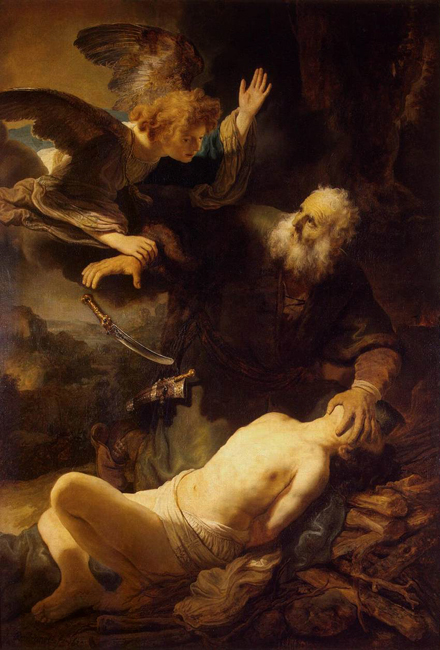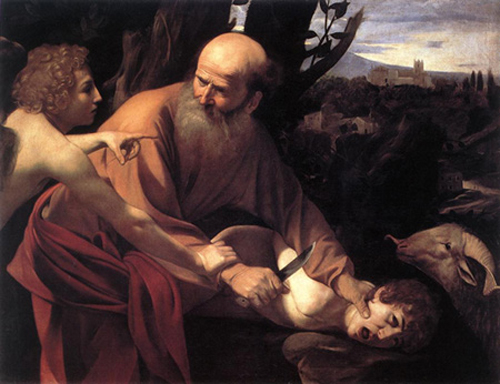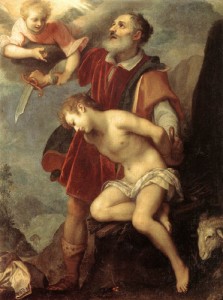Stories in Art: Abraham and Isaac
Monday, April 1st, 2013This is my fifth article in a monthly series of articles about paintings that tell ancient stories, drawing from my Stories in Art project.
Please click here for a full list of articles in this series.
~ § ~ § ~ § ~
The story of Abraham and Isaac is one of the most frustrating and fascinating stories in the bible. It’s frustrating because God gave Abraham an impossible task, and we’ll never know what would have happened if an angel had not interceded at the last minute. It’s fascinating for many, many reasons including the fact that artists nearly always depict the exact same moment of this complex story.
The story is brief, yet heavily weighed down by disturbing questions. God told Abraham to make the ultimate sacrifice: “Take your son, your only son, whom you love—Isaac—and go to the region of Moriah. Sacrifice him there as a burnt offering on a mountain I will show you” (Genesis 22) Although God had already asked a lot of Abraham by this point in his life, the old man dutifully set out to do as he was instructed. He bound his son and raised his knife, and then suddenly an angel appeared. The angel stopped Abraham, and pointed out a ram to be sacrificed instead.
Rembrandt’s The Sacrifice of Abraham captures this scene perfectly. Isaac is utterly defenseless and his vulnerability is almost painful to the viewer. Abraham is aged but bent forward with deliberate intention. His hand covering his son’s face is both violent and merciful, while his other hand dropped his knife when the angel arrived. Rembrandt depicted the utmost crucial moment of this story: the exact moment when the angel arrived and surprised Abraham. His knife has only fallen a few inches, which emphasizes the immediacy of this essential moment.
Many artists have taken on this intricate story, and paintings that depict well-known stories often vary in the exact moment that the artist chooses to depict. Some paint the early moments of a story while others paint the conclusion. In every single painting of Abraham and Isaac that I know of, the artist depicted the exact same moment in the story: the moment when the angel stopped Abraham from sacrificing his son. This is the moment when we learn that God wasn’t going to let Abraham hurt his son, and it’s also the moment when we learn that we’ll never know if Abraham was going to do it or not. This crucial moment sums up the entire story and opens up so many more questions.
To examine those questions, we’ll take a closer look at the characters in this scene, and other paintings that depict this deciding moment.
Isaac:
Although Abraham is the main character of this story, Isaac is often the most compelling figure in the scene. This is perhaps most true in Caravaggio’s take on the Abraham and Isaac story. Caravaggio often identifies with the victims in his paintings, and his Isaac is one of his most heart-wrenching figures. Both of Abraham’s arms draw our attention directly to Isaac, especially with Abraham’s firm grip on his knife and on Isaac’s neck. The danger here is imminent, and Isaac’s terror is acute. His expression conveys not only terror, but also shock and disbelief. Caravaggio’s scene draws our attention to the betrayal that Isaac must have felt when his father showed his determination to sacrifice him.
In depicting a story about a man whose choices are guided by God’s angels, some artists drew our focus to the terror of the innocent pawn caught in the middle of a dangerous test.
Abraham:
Was Abraham really going to kill his son? I find it incredibly frustrating that we’ll never know the answer to this question because the angel arrived before we find out if Abraham was about to follow through. Abraham was nothing if not dutiful, and he seemed intent on following God’s instructions regardless of how utterly crushed and bewildered he must have felt after hearing God’s command to sacrifice his long-awaited son.
Maybe Abraham knew all along that he would never have to follow through and actually kill his son. God had promised that Isaac would one day be a father, so Isaac would have to survive this ordeal somehow. But God works in mysterious ways, and even as Abraham raised his knife over his son, did he question whether God would allow his son to live?
Abraham must have been tortured by his thoughts in this moment, and few artists have managed to capture those emotions in the face of Abraham. Instead, it’s Abraham’s arms that tell the story: one arm restrains his son while the other arm is stopped in mid-air. Abraham is startled by the angel’s sudden arrival, and he turns away from his son to face the angel.
The Angel:
If you have every wondered what you would have done if God had tested you by asking you to sacrifice your son, then perhaps you have also wondered if God has ever sent an angel to guide your actions. Does God still send angels to stop us from doing terrible things? Perhaps history is full of moments that look just like paintings of Abraham and Isaac, and there are millions of never-painted scenes of angels arriving just in time. The scene of an angel stopping Abraham gives us hope that if we are as dutiful as Abraham, then God won’t let us do anything terrible.
The Feud that Sparked the Renaissance
The story of Abraham and Isaac has a very special place in the history of art. In 1401, several artists entered a competition for the prestigious job of decorating the doors of the Baptistery of St. John in Florence. The winner of the competition, Lorenzo Ghiberti, went on to spend the next fifty years of his life casting spectacular scenes on the bronze doors of the baptistery, while the runner-up went on to become the ingenious architect of Florence’s most recognizable feature: the enormous dome of the cathedral.
This baptistery competition, which jump-started the spectacular period of artistic growth known as the Renaissance, focused on the theme of Abraham and Isaac. The competitors were to submit a bas-relief panel illustrating this dramatic scene. It is telling that this theme was chosen for the competition among so many compelling religious themes. The winner of the competition was the first to capture the emotional depth of this scene, as well as the pictorial challenges of the moment that changed everything.
~ § ~ § ~ § ~
Resources:
- The Woman Who Named God: Abraham’s Dilemma and the Birth of Three Faiths by Charlotte Gordon
- The Feud That Sparked the Renaissance: How Brunelleschi and Ghiberti Changed the Art World, Paul Robert Walker
~ § ~ § ~ § ~
More articles:
Previous article: Abraham and Hagar | Next article: Rebekah at the Well





